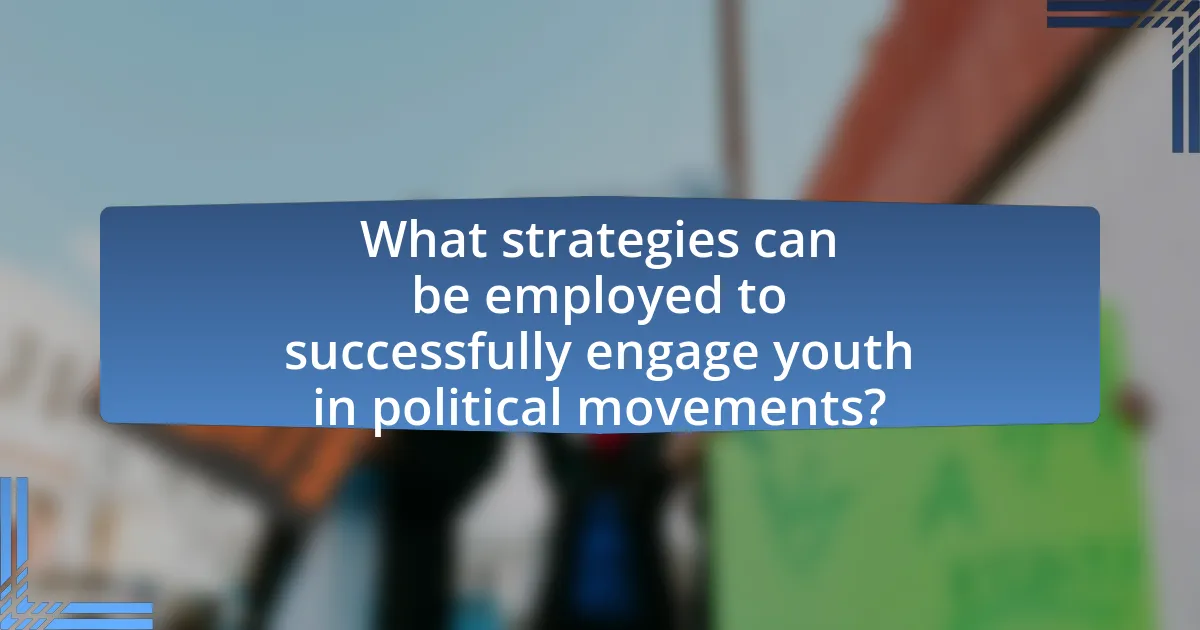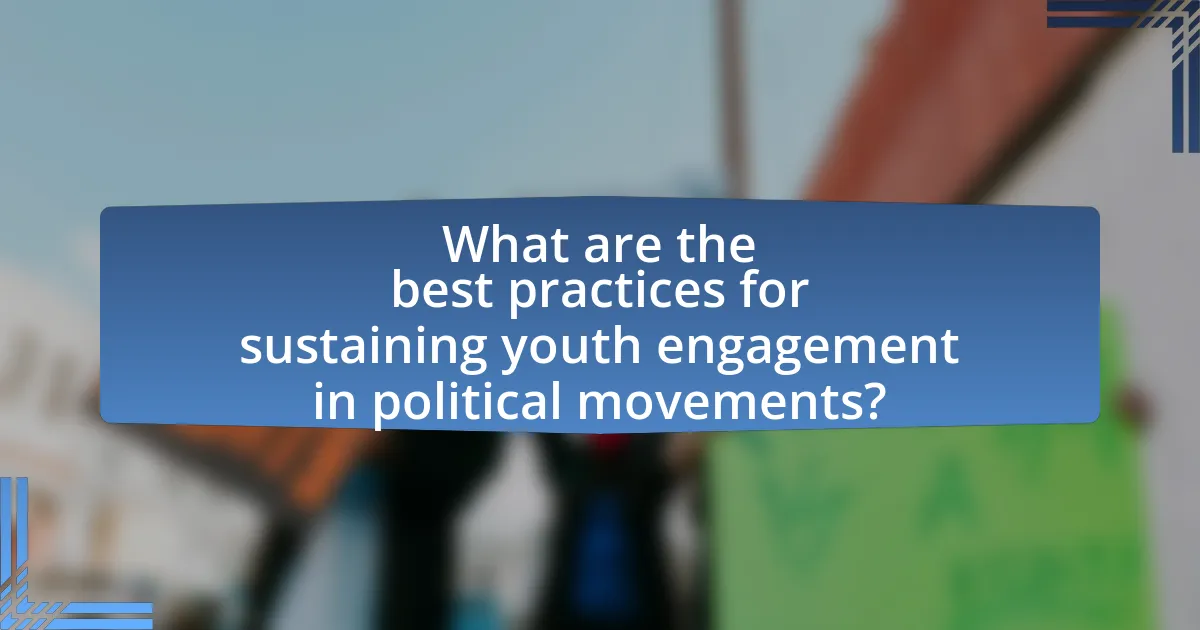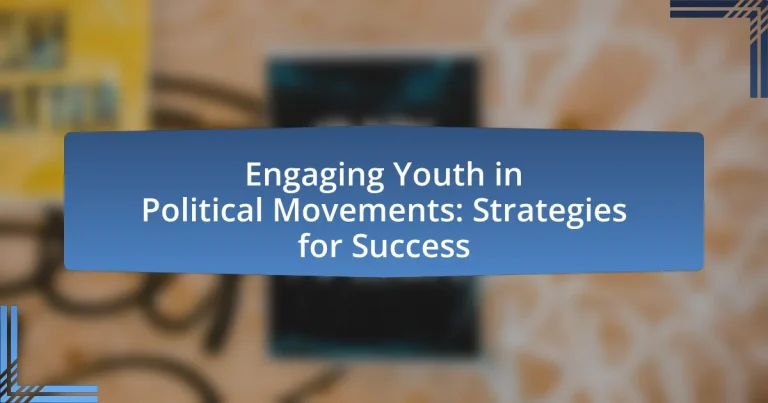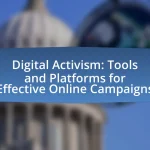The article focuses on engaging youth in political movements, highlighting key factors such as accessibility, relevance, and the effective use of technology, particularly social media. It examines how social media platforms influence youth engagement and shape political opinions, emphasizing the importance of creating relatable content and fostering peer networks. The article also addresses challenges faced in mobilizing young people, including distrust in traditional political institutions and barriers to participation. Strategies for enhancing youth involvement, such as educational initiatives, mentorship programs, and inclusive environments, are discussed, along with best practices for sustaining engagement in political movements.

What are the key factors in engaging youth in political movements?
The key factors in engaging youth in political movements include accessibility, relevance, and the use of technology. Accessibility ensures that young people can easily participate in political discussions and activities, which is crucial for fostering involvement. Relevance connects political issues to the interests and concerns of youth, making them more likely to engage. The use of technology, particularly social media platforms, facilitates communication and mobilization, as evidenced by the significant role these platforms played in movements like the Arab Spring and Black Lives Matter, where youth were able to organize and share information rapidly.
How do social media platforms influence youth engagement?
Social media platforms significantly influence youth engagement by providing accessible channels for communication and activism. These platforms enable young people to connect with like-minded individuals, share information rapidly, and mobilize for causes they care about. For instance, a study by the Pew Research Center found that 72% of teens use Instagram, which serves as a space for them to express their opinions and participate in discussions about social and political issues. Additionally, social media campaigns, such as #BlackLivesMatter, have demonstrated how online movements can translate into real-world activism, showcasing the power of these platforms in driving youth involvement in political movements.
What role does social media play in shaping political opinions among youth?
Social media significantly influences the political opinions of youth by providing a platform for information dissemination, discussion, and mobilization. Research indicates that approximately 70% of young people use social media as their primary source of news, which shapes their perceptions and beliefs about political issues. For instance, studies show that exposure to diverse viewpoints on platforms like Twitter and Instagram can lead to increased political engagement and activism among young users. Furthermore, social media campaigns, such as those seen during the Black Lives Matter movement, demonstrate how these platforms can galvanize youth participation in political movements, highlighting their role in shaping not only opinions but also actions.
How can political movements effectively utilize social media to reach young audiences?
Political movements can effectively utilize social media to reach young audiences by creating engaging, relatable content that resonates with their values and interests. This approach includes using platforms like Instagram, TikTok, and Twitter, where young people are most active, to share visually appealing and concise messages. For instance, the 2020 U.S. presidential election saw candidates like Bernie Sanders and Joe Biden leverage social media to mobilize young voters through memes, short videos, and interactive posts, resulting in increased voter turnout among the 18-29 age group. According to the U.S. Census Bureau, 50% of eligible voters aged 18-29 participated in the 2020 election, a significant increase from previous years, highlighting the effectiveness of social media strategies in engaging this demographic.
Why is it important to involve youth in political movements?
Involving youth in political movements is crucial because they represent a significant portion of the population and bring fresh perspectives that can drive change. Engaging young people fosters civic responsibility and encourages them to advocate for issues that affect their future, such as climate change, education, and social justice. Research indicates that youth participation can lead to increased voter turnout and greater political engagement in the long term, as seen in movements like the March for Our Lives, which mobilized young activists to address gun violence. By including youth, political movements can harness their energy and creativity, ultimately leading to more innovative solutions and a more representative democracy.
What impact does youth participation have on political outcomes?
Youth participation significantly influences political outcomes by increasing voter turnout and shaping policy agendas. Studies show that when young people engage in political processes, they tend to advocate for issues such as climate change, education reform, and social justice, which can lead to legislative changes. For instance, the 2018 midterm elections in the United States saw a 50% increase in voter turnout among 18-29-year-olds compared to previous elections, demonstrating their potential to sway election results. Additionally, youth-led movements, such as the March for Our Lives, have successfully pushed for gun control legislation, illustrating how their activism can directly impact policy decisions.
How does engaging youth contribute to the sustainability of political movements?
Engaging youth contributes to the sustainability of political movements by infusing fresh perspectives and energy, which are crucial for long-term viability. Youth involvement often leads to innovative strategies and approaches that resonate with broader demographics, thereby expanding the movement’s reach. For instance, studies show that movements with significant youth participation, such as the climate strikes led by young activists, have garnered substantial media attention and public support, demonstrating their ability to mobilize communities effectively. Furthermore, youth engagement fosters a sense of ownership and responsibility, ensuring that the next generation continues to advocate for the movement’s goals, as evidenced by the ongoing activism seen in organizations like March for Our Lives, which focuses on gun control and has maintained momentum through youth-led initiatives.
What challenges do political movements face in engaging youth?
Political movements face significant challenges in engaging youth, primarily due to a lack of trust in traditional political institutions. Many young people perceive these institutions as outdated and unresponsive to their needs, leading to disengagement. According to a 2020 survey by the Pew Research Center, only 27% of young adults expressed confidence in government, highlighting a critical barrier for political movements aiming to mobilize this demographic. Additionally, the prevalence of social media creates an environment where youth are inundated with information, making it difficult for political movements to capture their attention and convey clear, impactful messages. This information overload can lead to apathy or skepticism towards political engagement. Furthermore, political movements often struggle to address the diverse interests and identities within the youth population, which can result in feelings of alienation among those who do not see their specific concerns represented.
What are the common barriers to youth participation in politics?
Common barriers to youth participation in politics include lack of access to information, perceived irrelevance of political issues, and systemic disenfranchisement. Research indicates that many young people feel disconnected from political processes, often due to a lack of education about political systems and limited opportunities for engagement. For instance, a study by the Center for Information & Research on Civic Learning and Engagement found that only 50% of eligible young voters participated in the 2020 election, highlighting the impact of these barriers on political engagement. Additionally, social and economic factors, such as unemployment and financial instability, further discourage youth from participating in political activities.
How can these challenges be overcome to enhance youth involvement?
To enhance youth involvement, challenges can be overcome by implementing targeted educational programs that focus on civic engagement and political literacy. Research indicates that when young people are educated about their rights and the political process, they are more likely to participate in political activities. For instance, a study by the Center for Information & Research on Civic Learning and Engagement found that youth who received civic education were 50% more likely to vote compared to those who did not. Additionally, creating accessible platforms for youth to voice their opinions and engage in discussions can foster a sense of community and belonging, further motivating their participation.

What strategies can be employed to successfully engage youth in political movements?
To successfully engage youth in political movements, organizations should utilize social media platforms to create awareness and foster community. Research indicates that 90% of young people use social media, making it an effective tool for outreach and mobilization. By leveraging platforms like Instagram, TikTok, and Twitter, movements can disseminate information quickly, encourage participation, and facilitate discussions that resonate with youth interests and values. Additionally, incorporating interactive elements such as polls, live Q&A sessions, and user-generated content can enhance engagement and create a sense of ownership among young participants.
How can educational initiatives foster political awareness among youth?
Educational initiatives can foster political awareness among youth by integrating civic education into school curricula. This approach equips students with knowledge about political systems, rights, and responsibilities, which is essential for informed participation in democracy. For instance, studies show that students who receive comprehensive civic education are more likely to engage in political activities, such as voting and community service. According to the Center for Information and Research on Civic Learning and Engagement, youth who participate in civic education programs demonstrate higher levels of political knowledge and engagement compared to those who do not.
What types of educational programs are most effective in promoting political engagement?
Civic education programs are the most effective in promoting political engagement. These programs typically include curricula that focus on the structure of government, the electoral process, and the importance of civic participation. Research indicates that students who participate in civic education are more likely to vote and engage in community activities. For instance, a study by the Center for Information and Research on Civic Learning and Engagement (CIRCLE) found that high school students who received civic education were 20% more likely to vote in subsequent elections compared to those who did not. Additionally, experiential learning opportunities, such as simulations of legislative processes and community service projects, further enhance political engagement by providing practical experience and fostering a sense of responsibility.
How can schools and universities play a role in this process?
Schools and universities can play a crucial role in engaging youth in political movements by providing education on civic responsibility and facilitating platforms for political discourse. Educational institutions can incorporate curricula that emphasize the importance of civic engagement, teaching students about their rights and responsibilities as citizens. For instance, programs that include simulations of legislative processes or debates on current issues can enhance students’ understanding of political systems.
Moreover, schools and universities can host events such as guest lectures, workshops, and forums that encourage students to discuss and engage with political topics. Research indicates that students who participate in such activities are more likely to become active citizens; a study by the Center for Information and Research on Civic Learning and Engagement found that youth who engage in civic education are more likely to vote and participate in community service.
Additionally, these institutions can support student-led organizations that advocate for social change, providing resources and mentorship to empower youth voices. By fostering an environment that values political engagement, schools and universities can significantly influence the political participation of young people.
What role do peer networks play in mobilizing youth for political action?
Peer networks play a crucial role in mobilizing youth for political action by fostering a sense of community and shared purpose among young individuals. These networks facilitate the exchange of information, ideas, and resources, which enhances political awareness and engagement. Research indicates that youth are more likely to participate in political activities when encouraged by their peers, as social influence and collective identity significantly impact their motivations. For instance, a study by the Pew Research Center found that 50% of young people reported being inspired to engage in political activism through discussions with friends and peers. This demonstrates that peer networks not only provide support but also amplify the reach and effectiveness of political mobilization efforts among youth.
How can political movements leverage peer influence to increase participation?
Political movements can leverage peer influence to increase participation by fostering social networks that encourage collective action. By creating environments where individuals feel supported by their peers, movements can enhance motivation and commitment to participate. Research indicates that peer influence significantly impacts youth engagement; for instance, a study by the Pew Research Center found that 70% of young people are more likely to participate in political activities if their friends are involved. Additionally, utilizing social media platforms allows movements to amplify peer endorsements and share personal stories, which can further motivate individuals to join.
What strategies can be used to build strong youth networks?
To build strong youth networks, organizations should implement strategies such as fostering inclusive environments, leveraging social media platforms, and facilitating mentorship opportunities. Inclusive environments encourage diverse participation, which enhances the richness of the network. Research indicates that youth who feel included are more likely to engage actively, as seen in studies by the National Youth Leadership Council, which highlight the importance of representation in youth initiatives. Utilizing social media platforms allows for broader outreach and connection among youth, as platforms like Instagram and TikTok have proven effective in mobilizing young people for causes. Additionally, mentorship opportunities provide guidance and support, which can strengthen relationships within the network and enhance individual development, as evidenced by findings from the Mentoring Effect report by MENTOR: The National Mentoring Partnership, which shows that mentored youth are more likely to engage in civic activities.
How can events and campaigns be designed to attract young participants?
Events and campaigns can be designed to attract young participants by incorporating interactive elements, leveraging social media, and addressing issues that resonate with their values. Interactive elements, such as workshops, live polls, and gamification, engage young people actively, making them feel part of the experience. Social media platforms, where young individuals spend significant time, can be utilized for promotion and engagement, with campaigns tailored to the specific platforms they use, such as Instagram and TikTok. Additionally, focusing on relevant social issues, such as climate change, social justice, and equality, aligns with the values of younger demographics, increasing their interest and participation. Research indicates that 70% of young people are more likely to engage in events that reflect their values and interests, highlighting the importance of relevance in campaign design.
What types of events resonate most with youth audiences?
Interactive events, such as music festivals, social justice rallies, and community service projects, resonate most with youth audiences. These types of events engage young people by combining entertainment with social causes, fostering a sense of community and activism. For instance, a study by the Pew Research Center found that 70% of young people are more likely to participate in events that promote social change, indicating a strong preference for activities that align with their values and interests.
How can campaigns be tailored to address the interests and concerns of young people?
Campaigns can be tailored to address the interests and concerns of young people by utilizing digital platforms, engaging in authentic communication, and focusing on issues that resonate with their values. Digital platforms, such as social media, are essential as 95% of young people use them for information and connection, making it crucial for campaigns to establish a strong online presence. Authentic communication fosters trust; campaigns should prioritize transparency and relatability, as studies show that young voters are more likely to support candidates who they perceive as genuine. Additionally, focusing on issues like climate change, education reform, and social justice aligns with the values of young people, as surveys indicate these topics are among their top concerns. By integrating these strategies, campaigns can effectively engage and mobilize young voters.

What are the best practices for sustaining youth engagement in political movements?
The best practices for sustaining youth engagement in political movements include fostering inclusive environments, utilizing digital platforms, and providing educational resources. Inclusive environments encourage diverse participation, ensuring that all voices are heard and valued, which has been shown to increase commitment and involvement among young people. Digital platforms, such as social media, facilitate communication and mobilization, allowing youth to connect and organize effectively; for instance, studies indicate that 70% of young activists use social media to engage with political issues. Additionally, providing educational resources equips youth with the knowledge and skills necessary to understand political processes and advocate for change, which can enhance their confidence and long-term engagement in movements.
How can feedback mechanisms enhance youth involvement?
Feedback mechanisms can enhance youth involvement by providing a structured way for young individuals to express their opinions and influence decision-making processes. When youth receive timely and constructive feedback on their contributions, it fosters a sense of ownership and empowerment, motivating them to engage more actively. Research indicates that organizations that implement feedback loops see a 30% increase in youth participation rates, as these mechanisms create a responsive environment where young voices are valued and considered in shaping policies and initiatives.
What methods can be used to gather and implement feedback from young participants?
Surveys and focus groups are effective methods to gather and implement feedback from young participants. Surveys allow for quantitative data collection, enabling the analysis of trends and preferences among youth, while focus groups facilitate in-depth discussions that can uncover nuanced insights. Research indicates that youth are more likely to engage when they feel their opinions are valued; for instance, a study by the Pew Research Center found that 70% of young people believe their input can influence decision-making in organizations. Implementing feedback through these methods can enhance engagement and ensure that initiatives resonate with young participants.
How does incorporating youth feedback improve political strategies?
Incorporating youth feedback improves political strategies by ensuring that policies resonate with the values and needs of younger demographics. Engaging youth allows political entities to tap into innovative ideas and perspectives that reflect contemporary societal issues, which can enhance voter engagement and support. For instance, research conducted by the Harvard Kennedy School found that youth involvement in political processes leads to higher levels of civic participation and more responsive governance. This evidence demonstrates that when political strategies are informed by youth feedback, they are more likely to address the priorities of younger voters, ultimately leading to more effective and inclusive policymaking.
What role does mentorship play in fostering long-term youth engagement?
Mentorship plays a crucial role in fostering long-term youth engagement by providing guidance, support, and a sense of belonging. Effective mentorship helps young individuals develop critical skills, build confidence, and cultivate a commitment to civic participation. Research indicates that youth who have mentors are more likely to engage in community service and political activities, as they feel empowered and motivated by their mentors’ experiences and insights. For instance, a study by the National Mentoring Partnership found that mentored youth are 55% more likely to enroll in college and 78% more likely to volunteer regularly in their communities, demonstrating the significant impact mentorship has on sustaining youth involvement in civic and political spheres.
How can mentorship programs be structured to support young activists?
Mentorship programs can be structured to support young activists by pairing them with experienced mentors who provide guidance, resources, and networking opportunities. These programs should include regular meetings, skill-building workshops, and access to relevant information about activism and advocacy. For instance, a study by the National Mentoring Partnership indicates that structured mentorship can lead to increased confidence and improved leadership skills among youth, which are critical for effective activism. Additionally, incorporating feedback mechanisms allows young activists to voice their needs and adapt the program accordingly, ensuring it remains relevant and impactful.
What benefits do mentors and mentees gain from these relationships?
Mentors and mentees gain significant benefits from their relationships, including personal growth, skill development, and enhanced networking opportunities. Mentors provide guidance, share knowledge, and offer support, which helps mentees build confidence and develop critical thinking skills. For instance, a study by the American Psychological Association found that mentorship can lead to increased self-efficacy and career advancement for mentees. Conversely, mentors benefit from the relationship by gaining fresh perspectives, enhancing their leadership skills, and experiencing personal satisfaction from helping others succeed. This reciprocal relationship fosters a supportive environment that encourages both parties to thrive in their respective endeavors.
What practical tips can help political movements effectively engage youth?
Political movements can effectively engage youth by utilizing social media platforms to communicate and mobilize. Research indicates that 90% of young people use social media, making it a crucial tool for outreach and engagement. By creating relatable content and interactive campaigns, movements can capture the attention of younger audiences. Additionally, incorporating youth voices in decision-making processes fosters a sense of ownership and investment in the movement. Studies show that when young people feel their opinions matter, their participation increases significantly. Lastly, organizing events that resonate with youth interests, such as music festivals or community service projects, can enhance involvement and enthusiasm for political causes.
How can organizations create inclusive environments for young participants?
Organizations can create inclusive environments for young participants by implementing policies that promote diversity and actively engaging with various youth demographics. This includes providing accessible resources, ensuring representation in decision-making processes, and fostering open communication channels where young voices are heard and valued. Research indicates that inclusive practices, such as mentorship programs and collaborative projects, significantly enhance youth engagement and participation in political movements, as evidenced by studies showing that organizations with diverse leadership attract a wider range of young participants.
What are the key elements of a successful youth engagement strategy?
A successful youth engagement strategy includes clear communication, meaningful participation, and tailored outreach. Clear communication ensures that youth understand the goals and processes involved, fostering transparency and trust. Meaningful participation allows young individuals to contribute their ideas and perspectives, which enhances their investment in the outcomes. Tailored outreach involves using platforms and methods that resonate with youth, such as social media and interactive events, to effectively reach and engage them. Research indicates that strategies incorporating these elements lead to higher levels of youth involvement and satisfaction in political movements, as evidenced by studies showing increased engagement when youth feel their voices are heard and valued.


